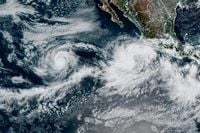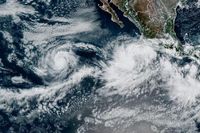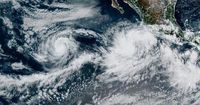On Saturday, October 4, 2025, the eastern Pacific Ocean delivered a new threat to Mexico’s coastline as Tropical Storm Priscilla officially formed, drawing the attention of meteorologists, local authorities, and millions of coastal residents. The Miami-based National Hurricane Center (NHC) swiftly classified Priscilla as a "large tropical storm," with a wind field stretching a remarkable 140 miles (220 kilometers) from its center—a size that immediately set it apart from many storms of the season, according to reports from the Associated Press and NHC advisories.
At 2:00 PM MST, the NHC issued its first advisory, pinpointing Priscilla’s center near latitude 15.5 North and longitude 106.6 West. That placed it about 285 miles (455 kilometers) southwest of Manzanillo, a major port city, and some 555 miles (895 kilometers) south-southeast of the tip of Baja California. The storm was crawling northwest at just 3 mph (6 kph), a slow pace that often spells trouble for coastal regions—more time over warm water can mean more strengthening, and a slow-moving system can dump excessive rain over the same areas for days on end.
Priscilla’s maximum sustained winds clocked in at 45 mph (75 kph), with higher gusts possible. While this placed the system squarely in tropical storm territory, forecasters warned that it was expected to intensify rapidly. The NHC projected Priscilla would reach hurricane status—defined by sustained winds of at least 74 mph (119 kph)—by Sunday night or early Monday, October 5 or 6, 2025. The storm’s forecast track showed it moving generally parallel to the southwestern Mexican coastline, a pattern that can create a prolonged period of hazardous weather for communities along the shore.
In response, the Mexican government issued a tropical storm watch stretching from Punta San Telmo to Punta Mita. This watch meant that tropical storm conditions—winds, heavy rain, and dangerous surf—were possible in the area within 48 hours. The NHC urged residents and visitors in these regions to prepare for the possibility of rapidly deteriorating weather as early as Sunday, with the potential for impacts to extend into Monday.
But what does this mean for those living and working along Mexico’s Pacific coast? The NHC’s key messages emphasized the risks: "Heavy rainfall associated with Priscilla will impact coastal sections of southwestern Mexico through Monday, which could result in flash flooding, particularly in areas of higher terrain." The threat wasn’t limited to wind and rain. With such a large wind field, Priscilla was already generating powerful swells and rip currents. The NHC cautioned, "Swells generated by Priscilla are affecting portions of the coast of southwestern Mexico and will reach the coasts of west-central Mexico and the southern Baja California peninsula by Monday. These swells are likely to cause life-threatening surf and rip current conditions."
The rainfall forecast painted a sobering picture. Coastal portions of Michoacán and far western Guerrero were expected to receive 4 to 6 inches of rain, with isolated pockets potentially seeing up to 8 inches. Colima, western Jalisco, and other parts of coastal Guerrero could expect 2 to 4 inches. For communities in these areas, especially those in mountainous terrain or flood-prone zones, the risk of flash flooding and mudslides was real and urgent.
As if one storm weren’t enough, Priscilla’s arrival coincided with another Pacific system: Tropical Storm Octave. Octave, however, was meandering far from shore, with maximum sustained winds of 65 mph (100 kph). The NHC made clear that Octave posed no immediate threat to land, with no coastal watches or warnings in effect. Still, the presence of two named storms in the region underscored the intensity of the 2025 Eastern Pacific hurricane season—Priscilla was already the 16th named system of the year.
For now, all eyes remained fixed on Priscilla’s slow, northwestward progress. The NHC’s forecast called for a measured northward drift through Sunday, followed by a faster northwestward motion beginning Monday. The storm’s center was expected to remain offshore, but forecasters warned that even a slight eastward deviation in track could bring much more severe impacts to the coast. With so much at stake, the NHC planned to issue intermediate advisories at 5:00 PM MST Saturday, followed by comprehensive updates every six hours as Priscilla evolved.
Local authorities and emergency management agencies urged residents from Punta San Telmo to Punta Mita—and even those farther north in southern Baja California Sur—to stay alert and monitor official updates. The risk of rapid intensification and sudden changes in track meant that conditions could deteriorate quickly, leaving little time for last-minute preparations.
The timing of Priscilla’s approach couldn’t have been worse for some. The storm threatened to disrupt the critical harvest period in several agricultural regions, and major tourist destinations along the coast braced for the possibility of closures and evacuations. With life-threatening surf, rip currents, and the potential for flash flooding, beachgoers and mariners were strongly advised to heed warnings and avoid the water until conditions improved.
Satellite imagery released by the National Oceanic and Atmospheric Administration (NOAA) showed Priscilla as a sprawling system, its cloud bands stretching hundreds of miles across the Pacific. Meteorologists noted that the storm’s large size and slow movement could prolong hazardous conditions, even if the center remained offshore. The combination of heavy rain, strong winds, and dangerous surf was expected to persist for several days, making it imperative for communities to remain vigilant.
As the 2025 hurricane season continued to churn out powerful systems, Priscilla’s formation served as a stark reminder of the region’s vulnerability. The NHC’s warnings were clear: "Tropical storms can rapidly intensify and alter course with minimal warning." For residents and visitors along Mexico’s Pacific coast, preparation and caution were the order of the day.
While the world watched and waited, emergency officials, meteorologists, and local communities braced for whatever Priscilla might bring—hoping for the best, but preparing for the worst.



